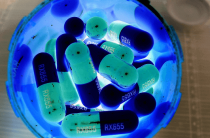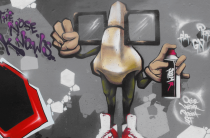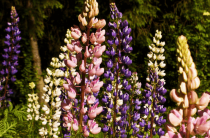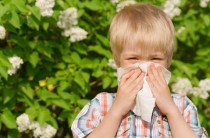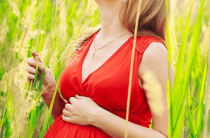Allergy to flowering is a condition that is characterized by the development of pathological sensitivity of the patient's body to the components contained in plant pollen. All this is expressed in a number of symptoms that cause great inconvenience to the patient, during the flowering period of the plant - the allergen.
In the case of an allergy to flowering, there are a number of factors that provoke its prevalence among modern urban residents:
- Poor environmental conditions in the place of residence of the patient. Modern industry excessively pollutes the air with waste products from its production, which have an adverse effect on the patient's immunity;
- Heredity. In the occurrence of allergic diseases, the factor of heredity plays an important role. For an increased risk of developing an allergy to dust, it is enough that one of the relatives of the baby suffers from allergies;
- Use of a large number of household chemicals. Most modern products of cosmetics, household chemicals and perfumery provoke excessive respiratory sensitivity, which leads to the development of allergic reactions to components that spread through the air;
- Lack of breastfeeding in a baby or its too early termination;
- High level of background radiation;
- Nutrition, consisting of products of non-natural origin, containing preservatives, dyes, stabilizers and other substances.
- Lack of physical activity, in which the immune system becomes weaker;
- Excessively strong enthusiasm for the hygiene of living conditions, as a result of which the immune system does not adequately contact irritants. On this point, it would be most acceptable to observe reasonable moderation;
Flower allergy symptoms
Allergy to flowering mainly has respiratory (affecting the respiratory system), conjunctival symptoms (eyes and adjacent skin areas) and dermatological manifestations. The symptoms of pollen allergy are characterized by their strict dependence on the flowering of the plant - the allergen. They appear when the plant begins to bloom and noticeably fade when this flowering disappears.
Respiratory manifestations of an allergy to flowering are manifested by nasal congestion, which makes breathing difficult; constant sneezing; secretion of a clear liquid; dryness and irritation of the sinuses.
Symptoms of conjunctivitis include redness of the eyes, their increased photosensitivity, discomfort in the eye area, crusting on the eyelids, redness of the eyes, watery eyes.
Skin manifestations are characterized by the appearance of allergic ulcers, drying of the skin, severe itching and peeling, redness of the skin.
Separately, asthmatic manifestations are distinguished in case of allergy to pollen. In this case, they speak of bronchial asthma of an allergic nature. This means that asthma symptoms develop only after contact with the allergen.
Bronchial asthma with allergies occurs when, in response to an allergen, a narrowing occurs in the diameter of the bronchial lumen. As a result, suffocation develops, accompanied by a dry cough and pain in the chest.
In addition to standard remedies for the treatment of allergies, the treatment of asthmatic manifestations also includes beta-receptor agonists (clenbuterol), which allow you to expand the lumen of the bronchi and make breathing easier.
Pollen Allergy Diagnosis
First of all, for successful treatment, the patient needs to know which pollen of which particular plant causes allergies in him. Often, many groups of plants (garden trees, flowers, weeds) have cross-flowering, which makes it sometimes difficult to recognize a particular allergen. For this, special diagnostic measures are carried out: skin tests, provocative tests, a blood test for antibodies.
Carrying out diagnostic measures takes place in the conditions of medical laboratories, since it requires the availability of special medical equipment, as well as qualified laboratory personnel.
In no case should you try to determine the pollen allergy yourself, since direct contact with the allergen always carries the potential risk of developing a severe form of an allergic reaction, which involves respiratory failure due to laryngeal edema.
Skin tests
Skin tests involve direct contact of the patient's epidermis with a group of suspected allergens, with further monitoring of their reaction at the site of contact. An allergen test is considered positive if a standard allergic reaction with characteristic localized forms of dermatitis occurs at the sites of application to the skin.
During skin tests, it is necessary to observe the patient's condition for 72 hours. During these activities, it is necessary to observe precautions aimed at combating exacerbations, since this test involves direct contact of the patient with the allergen. As a result of this, exacerbations such as extensive urticaria, angioedema and anaphylactic shock may occur.
Skin are carried out by the following methods:
- The imposition of a special application bandage on the skin. During this test, it is necessary to refrain from washing in the shower and any activity that contributes to increased sweating;
- The introduction of the allergen through small surgical incisions;
- The introduction of the allergen through injections;
Before skin tests, it is necessary to stop therapy with antihistamines and corticosteroids, 2-3 days before the start of the analysis. Under the condition of long-term use, this point is discussed separately, due to the fact that these substances, with prolonged use, can have a cumulative effect.
Skin tests are prohibited under the following conditions: exacerbation of an allergic reaction; pregnancy; infectious diseases; old age (60+ years).
Blood test for antibodies
This analysis allows you to detect an increase in the concentration of antibodies in contact with the allergen. For this purpose, a sample of the patient's blood is taken, which is then exposed to various allergens. Under the influence of an allergen, the concentration of special proteins - immunoglobulins, which are also called "antibodies", increases.
This method is extremely informative, since it diagnoses biochemical blood parameters characteristic of an allergic reaction. It has no contraindications, it is suitable for use in children and the elderly.
How to cure an allergy to flowering
Fortunately for patients, flowering allergy can be treated and done successfully, without harm to the health of the patient. This is done according to the testimony of competent specialists in the field of allergology, and in some cases, with the involvement of specialists from other areas of medicine. At the moment, in fact, no specific treatment for allergic diseases is known. There are two directions in therapy: prevention and relief of symptoms, which is carried out with the help of medications, in various forms of application.
Immunotherapy for pollen allergy
Immunotherapy of allergic diseases is a method based on the constant contact of the patient with the allergen. Solutions of the suspected allergen are given by injection. The concentration of the allergen with this method is much lower than that which the patient encounters in everyday life. The introduction of the allergen occurs constantly, for several months.
In case of pollen allergy, it is advisable to carry out therapy in periods from the end of autumn to the beginning of spring (or before the allergen plant begins to bloom). In this matter, a clear timing is important, since immunotherapy at the time of the presence of a large amount of allergen in the air is unsafe and ineffective.
In general, this is a very effective method that should be carried out under constant medical supervision. It must be understood that it involves the direct introduction of an allergen into the blood, and without appropriate medical supervision, this event can be very deplorable. Immunotherapy is never carried out during an exacerbation of the disease!
In various printed publications devoted to traditional medicine, it is said that it is necessary to use teas based on the pollen of the plant, an allergen, before flowering begins. This method is not reliable and threatens with the development of complications, since it is impossible to calculate an accurate and safe dosage with this approach. Using this type of immunotherapy, you just get another development of allergy symptoms, which can have very serious consequences and in any case worsen your health.
Pollen Allergy Medications
To date, medical science does not know such a medicine that would cope with the task of eliminating the very cause of pathologically active immunity.
Treatment is reduced to the use of drugs that eliminate the symptoms of allergies. For the treatment of allergic reactions, histamine blockers, corticosteroids, and vasoconstrictor drugs are used. These medicines are used both in forms for general use (tablets, injections, syrups) and for topical use (ointments, sprays, drops).
Antihistamines
The action of these drugs is based on the ability of these substances to block histamine receptors. This hormone, connecting with receptors on the surface of skin cells, the respiratory system, nasopharynx, etc. Due to the influence of this hormone, the patient experiences allergy symptoms. Antihistamines prevent this hormone from exerting a biological effect on cells, which prevents the development of allergy symptoms.
It is more advisable to use antihistamines before contact with the allergen (about 5 days before flowering). The more modern the antihistamine drug, the less side effects it has, and it also does not require less frequency of administration, which is due to the ability for prolonged contact with the cell receptor.
Demidrol is one of the first antihistamine drugs used to treat allergic diseases. It has a strong antihistamine effect, perfectly relieves the symptoms of allergic rhinitis (itchy and irritated nose, nasal congestion, allergic sneezing). It requires frequent use and has a pronounced side effect: it causes dry mouth, can provoke tachycardia, has a strong inhibitory effect, reduces the reaction, causes weakness and severe daytime sleepiness. Contraindicated in the last trimester of pregnancy, due to the serious threat of miscarriage provocation.
Diazolin - has a similar effect to demidrol, but does not have such a pronounced inhibitory effect. It strongly affects the performance of the gastrointestinal tract, can cause various disorders of the work of this organ.
Erius is a modern drug that does not cause CNS inhibition, therefore it does not provoke lethargy and daytime sleepiness. It perfectly relieves the symptoms of allergic rhinitis and manifestations of conjunctivitis in case of allergy to pollen. Side effects are relatively rare and are expressed as follows: drying of the oral mucosa, increased heart rate, dizziness, nausea, weakness. Desloratidin - the active ingredient of Erius is able to increase the activity of liver enzymes. To date, there is no accurate data on the use of this drug during pregnancy. Appointment for this condition is made if there is a high risk to the health of the mother and child.
Claritin is a modern drug, with a minimum number of side effects. It is a drug preferably used for pollen allergy, since it most effectively affects the manifestation of this disease. It does not have a toxic effect on the heart and a sedative effect. It has an effect of more than 12 hours from the moment of administration, therefore it does not require frequent use. The disadvantage of this drug is that loratidine passes into breast milk, so it is not suitable for breastfeeding.
Corticosteroids to treat allergies
Corticosteroid drugs (cortisone, hydrocortisone, dexamethasone, betamethasone) have the most powerful effect on relieving allergy symptoms. This is because they affect all the biological mechanisms that are responsible for the occurrence of an allergic reaction. They prevent the release of histamine and other factors necessary for an allergic reaction into the blood; prevent inflammation and allergic transformation of connective tissue; reduce the production of antibodies; suppress inflammatory processes.
There is one characteristic feature in the use of corticosteroid drugs: these drugs are not suitable for long-term use, since they have not only a powerful anti-allergic effect, but also powerful side effects. For this reason, they are usually prescribed for a period of no more than 5 days to relieve acute allergy symptoms. further treatment is carried out with other drugs with less pronounced side effects.
In the case when long-term therapy with corticosteroid drugs is necessary, concomitant drugs and dietary supplements are prescribed to maintain the efficiency of the adrenal cortex.
Allergy eye drops
Often the eyes are the organ that is most susceptible to allergic reactions in a patient when pollen enters. This is due to both the characteristic effect of the allergen on the organs of vision, and the fact that it is able to enter directly into the mucous membrane of the eyes and have a local irritating effect there.
Opatanol is a drug with antihistamine properties, used in the form of eye drops . Effectively removes the expansion of the eye vessels, redness, itching, reduces inflammatory reactions. This is a fairly safe drug that is suitable for long-term use. It is advisable to start using it a few days before the expected flowering of the plant - the allergen. Then it will be most effective.
Instillation into the eyes several times a day, 1-2 drops. The interval between use should be at least 8 hours.
Loteprednol - topical allergy drops, is a corticosteroid drug. Effectively relieves manifestations of allergic conjunctivitis, removing all symptoms of an allergic reaction in the eye area and adjacent tissues. It is prescribed in short courses, for 4-5 days, with acute manifestations of allergic reactions. With prolonged use, it can cause extensive side effects throughout the body. It is not recommended to use in infectious diseases in view of the fact that loterprednol, like any corticosteroid drug, depresses the immune system.
Vizin - vasoconstrictor drops that relieve redness and eye fatigue. It is not recommended to use more than 4 days, since there is a direct risk of vasodilatation, in the absence of active substance ingress.
Prevention of allergy to flowering
- During the flowering of the plant, do not take walks under the following conditions: morning and afternoon, windy and dry weather, in places where potential allergens accumulate;
- Use wet cleaning to prevent the accumulation of allergens in the room;
- Use special filters to purify indoor air from pollen;
- Use respirators and sunglasses to prevent pollen from entering;
- Install special window barriers
Attention! The purpose of this article is to introduce the phenomenon of pollen allergy. In no case do not use the information from this article, as well as from any other sources, for the purpose of self-treatment.
[perl] mosquito bite allergy [/perl]
